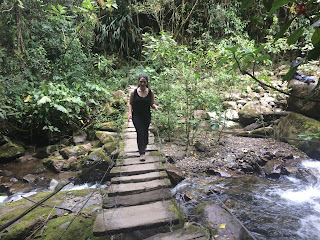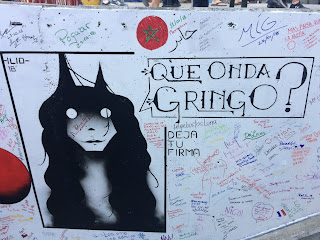WE get a relatively early start at 8:30 in the morning in the town square as we head up in an open-air jeep with room 8 plus 4 more hanging off the back. The 40 minute ride to the Cocora valley is a slow, relaxing drive through patches of sun.
At the jeep station, I have a breakfast of scrumptious panino on homemade baguette. The cafe owner considerately wraps half for lunch while I devour the other half with garlic sauce and gusto.
We begin our hike up the idyllic valley surrounded by steep walls of jungle and dotted with the 30m (~100ft) tall wax palms, which are the national tree. We enter a first and head uphill by a burbling stream. We cross it multiple times on rickety suspension bridges that only allow one person at a time.
The Cocora Valley, which is adjacent to Parque Nacional los Nevados, is well administered and cared for. Hardly any trash or graffiti, or side trails.
Up the hill for a while, we arrive at the hummingbird (colibri) sanctuary. I had expected an enclosed greenhouse full of birds, and was surprised to find the creatures flitting about in open air, free to come and go. What's more, they freely dine at feeders just inches away from phone and camera-wielding visitors.
We enjoy our hot chocolate and salty cheese--both freebies with sanctuary entrance fee. We watch a long-snouted mammal also scarfing the home-made cheese on the corner of the balcony where we all sat.
A brilliant green hummingbird with a long tail hanging two body-lengths below it captured everyone's attention, though my favorites were the smart-looking black and white Incan hummingbirds.
We left the sanctuary to walk up the fork of the trail marked 'La Montaña'--the mountain--with our trail buddies, which were a mix of French, German, Austrian, Swiss, Dutch, and Colombian.
The trail quickly grew steep and switchbacking before leveling off at a house built t the end of a gradually descending dirt road. We rested here with a bunch of others, surveying the clouds passing through the mountains.
At the jeep station, I have a breakfast of scrumptious panino on homemade baguette. The cafe owner considerately wraps half for lunch while I devour the other half with garlic sauce and gusto.
We begin our hike up the idyllic valley surrounded by steep walls of jungle and dotted with the 30m (~100ft) tall wax palms, which are the national tree. We enter a first and head uphill by a burbling stream. We cross it multiple times on rickety suspension bridges that only allow one person at a time.
 |
| Local Cocora resident |
 |
| Alex braving the sparse footing |
The Cocora Valley, which is adjacent to Parque Nacional los Nevados, is well administered and cared for. Hardly any trash or graffiti, or side trails.
Up the hill for a while, we arrive at the hummingbird (colibri) sanctuary. I had expected an enclosed greenhouse full of birds, and was surprised to find the creatures flitting about in open air, free to come and go. What's more, they freely dine at feeders just inches away from phone and camera-wielding visitors.
 |
| I almost had macro on for these incredibly patient subjects. |
We enjoy our hot chocolate and salty cheese--both freebies with sanctuary entrance fee. We watch a long-snouted mammal also scarfing the home-made cheese on the corner of the balcony where we all sat.
A brilliant green hummingbird with a long tail hanging two body-lengths below it captured everyone's attention, though my favorites were the smart-looking black and white Incan hummingbirds.
We left the sanctuary to walk up the fork of the trail marked 'La Montaña'--the mountain--with our trail buddies, which were a mix of French, German, Austrian, Swiss, Dutch, and Colombian.
The trail quickly grew steep and switchbacking before leveling off at a house built t the end of a gradually descending dirt road. We rested here with a bunch of others, surveying the clouds passing through the mountains.
 |
| The view at the top of our climb |
We followed the road back towards the keep station, stopping by groves of the famous wax palms. These enormous trees are usually 30-40m tall, but the record height is 65m. In the park they are surrounded by grazing cattle, which many of the locals look down on--those bovines trample the earth around each tree and chomp any new palms trying to shoot up. In 40 years they say the valley won't have any more palms in it.
 |
| Wax palms |
 |
| Caballos y palmas |
We walk back the final leg of the trail along a steep ridgeline shortcut. We wait for a large contingent of Colombian high schoolers to be taken back in the 6 waiting jeeps. That means another 50 minutes or so until the jeeps return, so Alex and I grab a tinto and wait.
The jeeps are all very old Willys type, made in Colombia, and lovingly maintained and decorated tastefully with chrome accents. They have extended back areas like pickup trucks, which allows for the longitudinal bench seating on either side to swallow 8 passengers.
As we ride back into town on the back of the Jeep, Alex and I chat with a Colombian man, about 18 years old, and a German, about 20. The Colombian asked about the feasibility of work visas in the US. We shrugged and encouraged him to apply.
Dinner was trout and chicken with mashed potatoes, beans, salad, fried plantain, and fritter, with a light chicken soup as a starter, washed down with lemonade-sugarcane juice.,
I sat in the beautiful old corner cafe with a beer as I caught up with my journal. Locals sipped coffee from the beautiful antique espresso machine. Alex bought earrings.
In the evening we headed over to Beta Town, a new looking event space that had a quiet foreign couple playing Tejo in the corner. Alex and I knew we had to give this game a try.
This (literally) explosive game is Colombia's national pastime, and it feels like beer pong and shuffleboard comibined. Steel pucks are thrown about 20m at a slanted clay tray. At the center of the tray is a 5" steel ring with three triangular gunpowder-laden envelopes spaced evenly around the rim. Points are earned when the puck sticks in the clay or detonates the packets. Lots of fun, and Alex beats me after a heated game.
 |
| Tejo target |
 |
| Sunset on the main square in Salento |































